My Favorite Oboz Hiking Boots – Reviewed
Trying to decide which pair of Oboz hiking boots to get? In this post I round up my favorites that I’ve worn over the years.
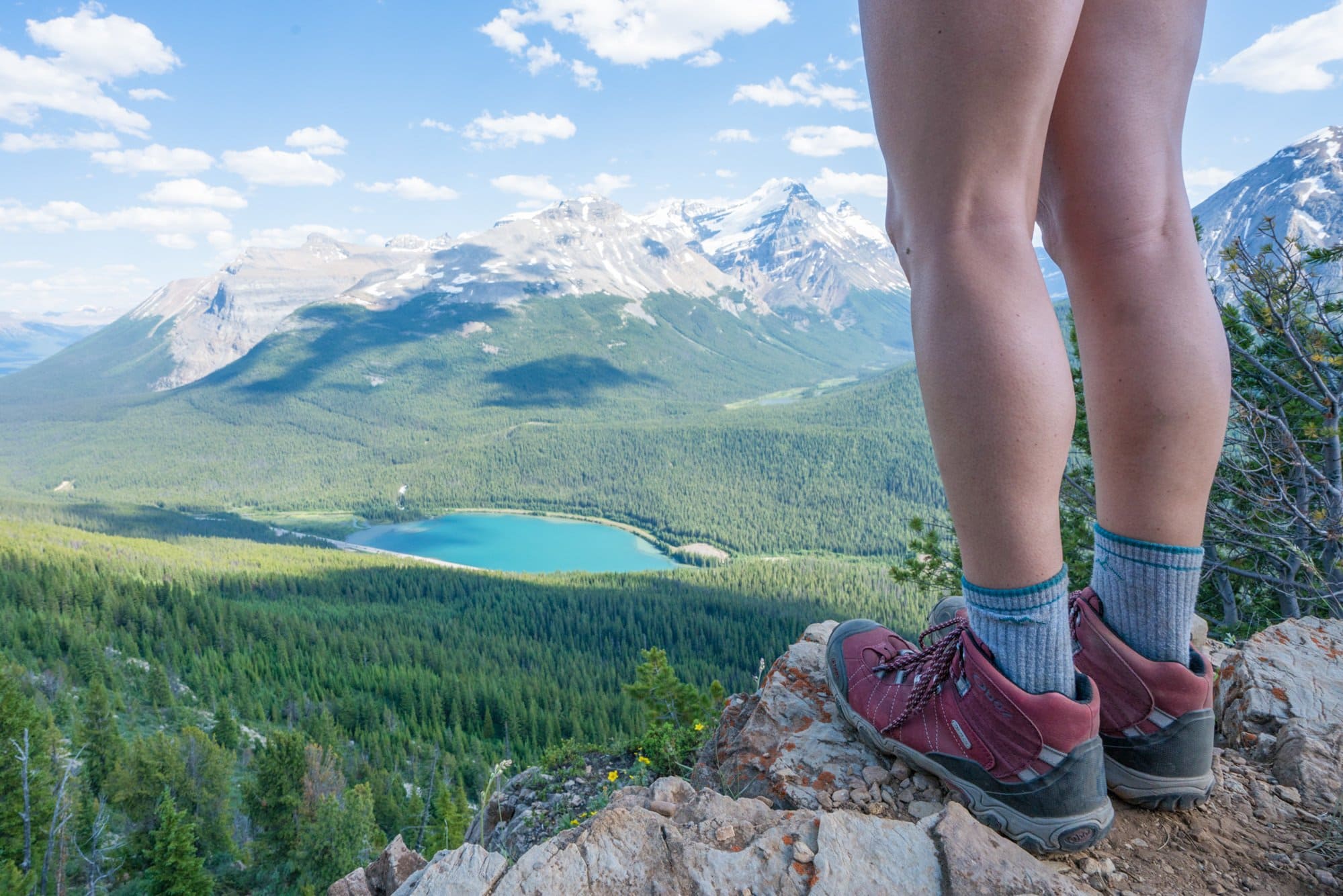
I’ve been wearing Oboz hiking boots for the last 8 years, and I’ve tried almost every shoe in their lineup. Whether I’m tackling a rugged backcountry trail, on a quick hike with my dogs, or looking for a stylish option to transition seamlessly from trail to town, there is a pair of Oboz that fits the bill.
If you’re trying to figure out which pair of Oboz hiking shoes is for you, in this post, I’ll share my favorite Oboz picks, from the sturdy Bridger Bdry for serious backpacking to the versatile Katabatic for everyday wear and everything in between.
Many of these come in waterproof and non-waterproof versions. If you need help deciding on that, check out my post on waterproof vs. non-waterproof hiking boots.
This post may contain affiliate links.
1. Oboz Bridger Mid Waterproof Hiking Boots
Pros and Cons
My Review
I’ve struggled with foot pain in the past when it comes to hiking boots, but Oboz women’s hiking boots have been a game-changer for me. They provide the support and comfort I need to enjoy long days on the trail without any discomfort.
For trips that require something super sturdy, especially when I’m backpacking, I rely on the Oboz Bridger Mid Waterproof Hiking Boots. These boots have been my go-to on countless big adventures, including a challenging 10-day backpacking trip in Alaska. The rugged terrain and constant rain were no match for these boots—they kept my feet completely dry, warm, and blister-free, even through bushwhacking and tough conditions.
I also wore them on a 5-day backpacking trip through Sequoia National Park, where I tackled the steep, rocky trail with a 40-pound pack. The Bridger Mids offer a solid, durable sole, a supportive insole, and fantastic ankle support, which helped immensely with balancing a heavy load. While moderately stiff, they still provide comfort over long distances, and there is no break in period required.
My feet are relatively flat and narrow, and these boots fit me perfectly. They sit about an inch above my ankle bone, and I love how the heel cup keeps my foot in place, eliminating any heel movement on ascents and descents.
If you have wider feet, the Bridger Mid also comes in a wide version. I recommend sizing up a half size to give your toes more room in the toe box, which adds extra comfort on long hikes.
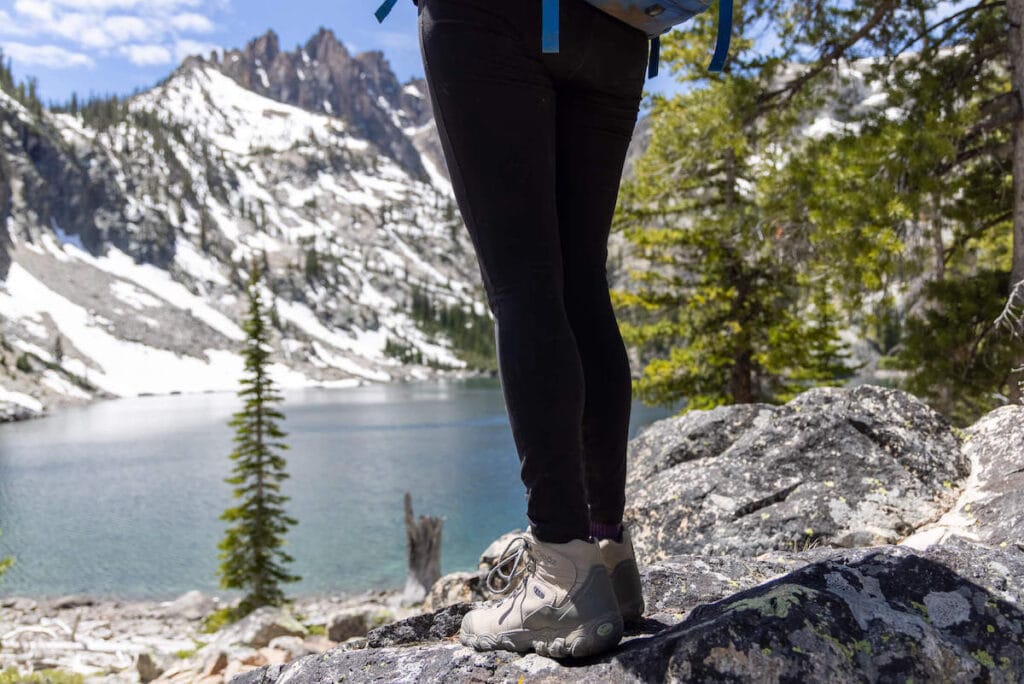

Tip: Clean your hiking boots!
In order to maintain the waterproofness of any hiking boot, it’s important to clean them periodically. Learn how to properly clean your hiking footwear here.
Save this post!
Enter your email & I'll send this post to your inbox! You'll also receive my weekly newsletter full of helpful advice for planning your adventures.
2. Oboz Katabatic Low Hiking Shoes
Pros and Cons
My Review
Except for long, burly backpacking trips, the Oboz Katabatic LT has completely replaced my need for heavier hiking boots. It’s the shoe I wear most days on the road, whether I’m tackling a steep, rocky trail or just hanging around camp. I’ve worn both the Low and Mid versions, and they’re now the only two hiking shoes I have with me in my truck camper.
They’re light enough to move quickly and comfortably but still provide enough structure and protection for long hikes and uneven terrain. I’ve tested them on dusty desert trails, loose scree, muddy creek crossings, and everything in between, and they’ve never let me down.
The O FIT insole and midsole cushioning keep my feet supported even on longer days, and the secure heel cup means no slipping or rubbing. I have relatively flat feet, and the arch support in these feels just right.
I typically wear the non-waterproof Low for warm, dry hikes when I want maximum breathability. The Mid waterproof version is my go-to for shoulder season hikes or when I’m carrying a pack on more rugged terrain. The waterproof model utilizes the new GORE-TEX Invisible Fit, which is the lightest and most breathable footwear waterproofing technology available. It only adds a few ounces to the shoe and is way more breathable than a traditional hiking boot.
If you’re looking for a versatile, trail-ready shoe that doesn’t weigh you down, the Oboz Katabatic LT is hard to beat.
3. Oboz Sawtooth X Low Hiking Shoes
Pros and Cons
My Review
The Oboz Sawtooth II was my go-to low-top hiking shoe for years, and I was excited to see the updated Sawtooth X model, released in 2022, which comes with even better traction and durability—especially useful for those wet, rainy days on the trail.
For bigger day hikes with steep, uneven terrain, the Sawtooth X Low is a great choice. These shoes are built tough, offering a sturdy, waterproof design with a super grippy sole that ensures great traction, whether on rock, mud, or loose dirt. They also feature an asymmetric collar around the ankle, designed to work with natural ankle bone variations, which I’ve found helpful for preventing chafing and rubbing on long hikes.
I’ve put these shoes to the test on steep Colorado 14ers, on my Trans-Catalina Trail backpacking trip, and clocked countless miles on easier day hikes. They’re even comfortable enough to wear around camp on cooler nights, making them a versatile option in any hiking wardrobe.
However, I do experience a bit of heel slippage with these, so if you have narrow heels or ankles, the Firebrand II may be a better fit (which I’ll discuss in more detail next).
Additionally, the Sawtooth X is available in a mid-ankle version if you prefer more ankle support, with both waterproof and non-waterproof options. I have the waterproof model, ideal for the mountain hikes I tend to do.
For an in-depth breakdown, check out my full Oboz Sawtooth X review.

4. Oboz Firebrand II
Pros and Cons
My Review
If you have narrow heels like me, you might find that the Oboz Sawtooth X allows for a bit of heel movement. That’s why I actually prefer the Oboz Firebrand II, which has the same supportive midsole and grippy outsole as the Sawtooth X.
This means you get identical cushion, stability, and traction, but with a couple of key upgrades for narrower feet. The Firebrand II has a slightly lower overall volume, which helps hug a narrower foot securely, and it features a larger heel drop, offering a bit more lift.
I wore the Firebrand II while pregnant, tackling rocky and steep trails in the Italian Dolomites. Even on challenging terrain, the locked-in feel around my heel gave me confidence, and the slightly stiffer construction provided solid support on uneven surfaces.
Oboz includes their BDry waterproofing on the Firebrand II, so you don’t have to worry about water sneaking into your shoes.
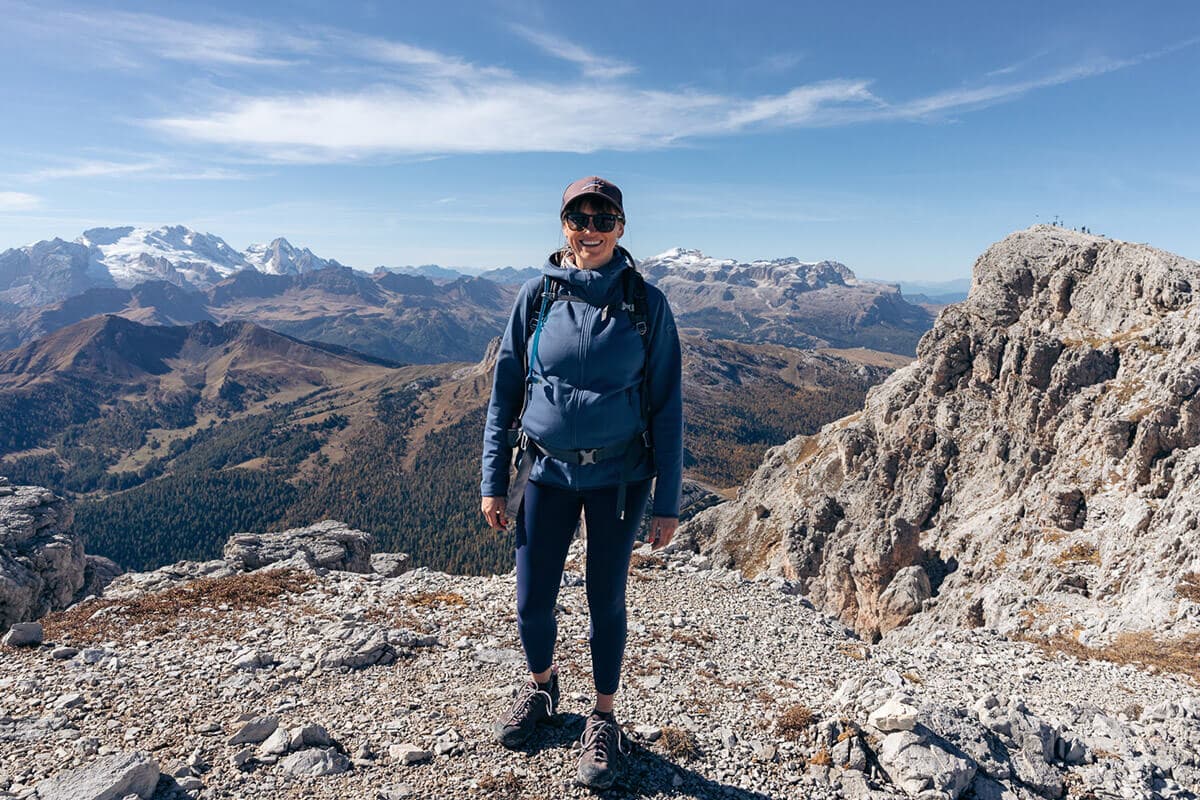
5. Oboz Bridger Insulated 9″
Pros and Cons
My Review
The Oboz Bridger Insulated boots have been my go-to for winter hiking and snowshoeing, and they’ve truly proven their worth in cold, snowy conditions. My feet get very cold (my toes even go numb sometimes), and right off the bat, I was impressed with how warm they kept my feet, thanks to the 400g 3M Thinsulate insulation.
For comfort, the O FIT Thermal insole is a great addition. It’s lined with wool and Mylar, adding another layer of insulation so my feet don’t feel cold from the bottom.
With the B-DRY waterproof membrane, my feet have stayed dry through slushy trails and snowbanks. Plus, the 9″ cuff on the women’s (10″ on men’s) is tall enough that I’m able to trudge through some powder without the snow entering the top of the boot.
Traction is another area where the Bridger Insulated excels. The outsole has deep lugs and a winter-ready rubber compound that grips well on snow and mixed terrain. I feel steady on my feet even on icy patches, although on pure ice, they can slip a bit, so I recommend pairing with microspikes if the trail is really slick.
They’re heavier than some other winter boots, though, which I definitely notice on longer hikes. At over 3 pounds a pair, the weight can start to feel like a workout, but for the warmth and protection they provide, it’s a trade-off I’m okay with.
If you want something lighter, these do come in a 7″ version (women’s) or 8″ version (men’s), but these only have 200 g of insulation compared to 400 g in the taller version.
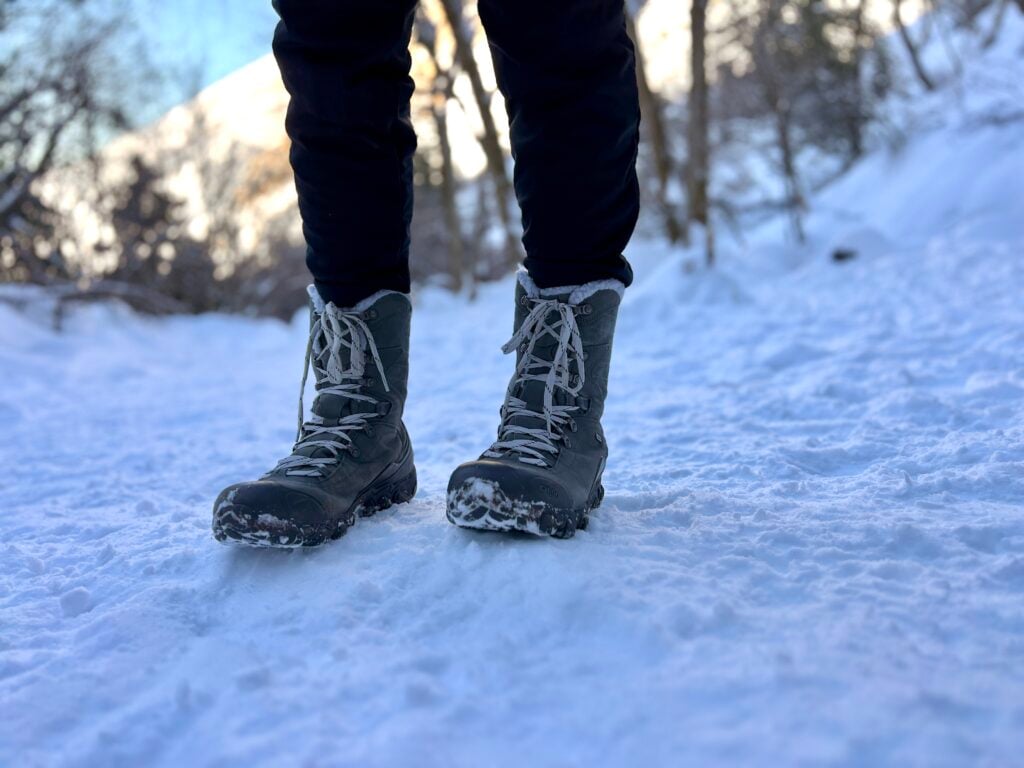
More Hiking Gear Posts
Save this post to Pinterest
Have you tried Oboz Footwear? What are your favorite of their hiking shoes?


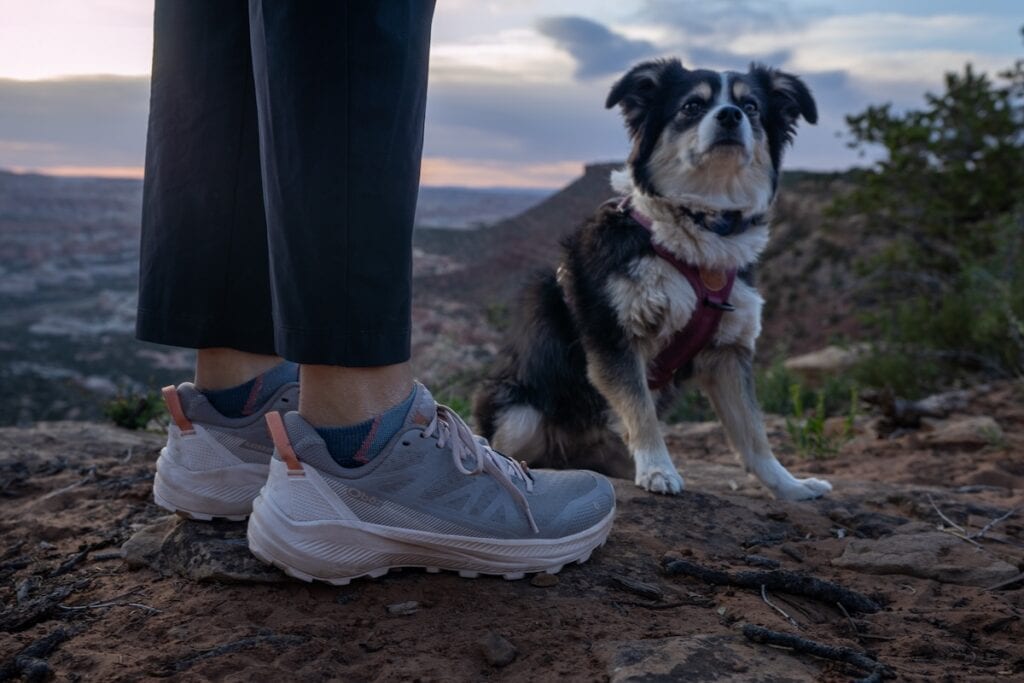
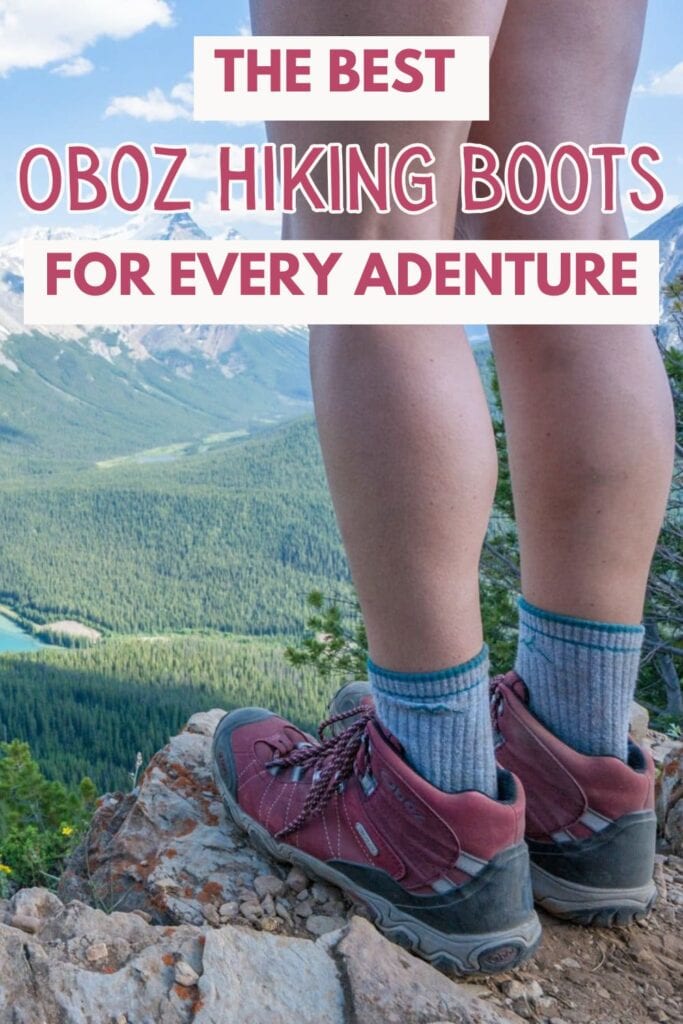
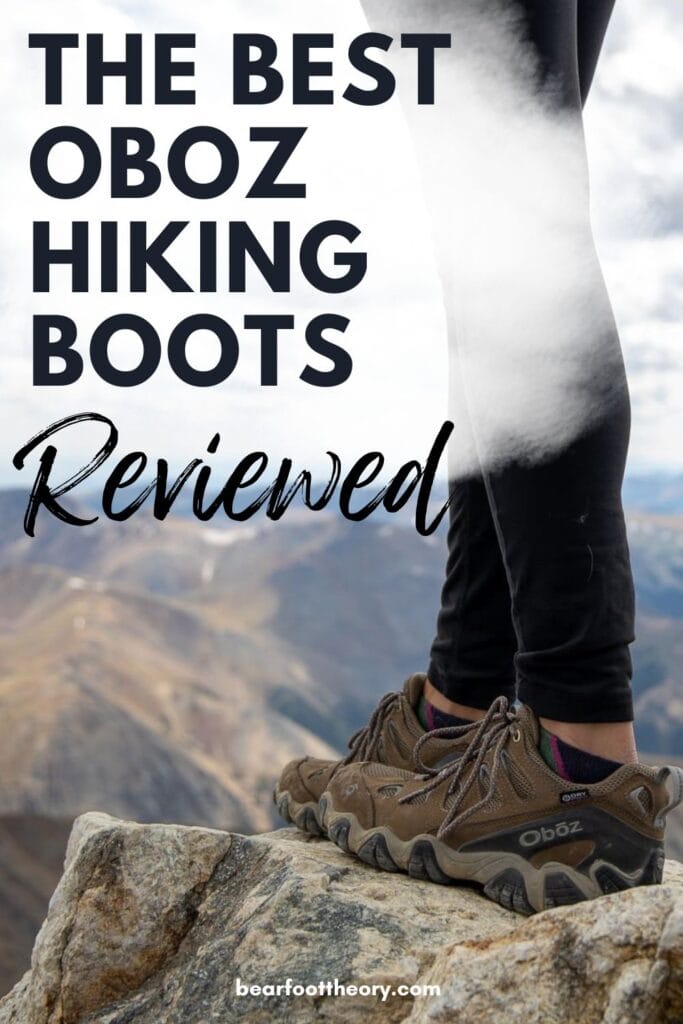
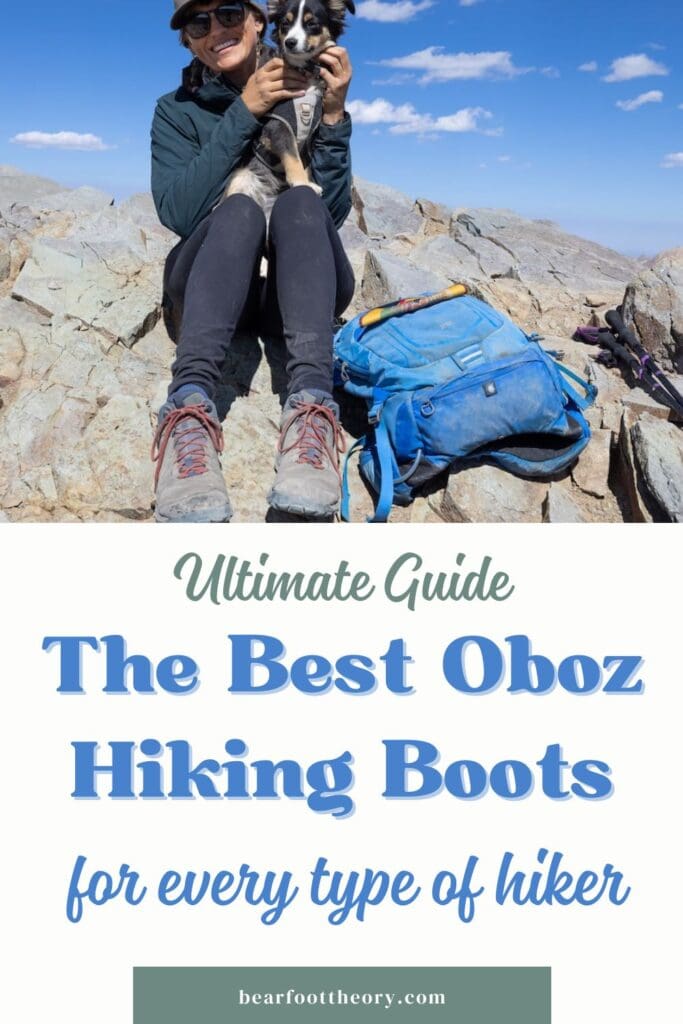
This is a lot of great information you’ve laid out here! Really appreciate the thorough post and recommendations.
Thanks for pointing out that the boots must be mixed in materials because it will be more flexible. With that in mind, I will be checking the material to choose a good pair of boots for my boyfriend. It is just the gift that I wanted to give him because I heard him one time that he would love to style himself with such footwear.
Hi, what is your oppinion on tje solomons woman x ultra 3 boot? We have a 6 day hik coming up and i am unsure! The other boots you spoke about is not in SA
Hi Christy, personally I’m not a huge fan of Salomon only because my mom snapped her laces on her Salomon hiking shoes and we haven’t been able to get replacement laces that work with the shoes. My mom really loved them before they broke but I’m hesitant to try them since durability is a big deal to me while in the backcountry. They do have good reviews online though and I have friends that swear by Salomon.
Great review, thanks for sharing your tips! Definitely will start looking at these for my next set of walking boots…
Hi Ladies,
Thank you so much for the information. It is challenging knowing the right/best boot to buy when your local stores do not carry a variety and therefore you rely on opinions or articles. We are planning a trip to Glacier/Banff/Jasper in early September. I’m looking for a second pair of hiking shoes to take along with my Merrel Siren Edge which performed well in the Utah National parks. We typically do easy-moderate trails up to 5 miles at any one time. I had been thinking about Brooks Cacsacdia 13 or now Keen Terradora low or mid. I don’t think I need mid or heavy hiking boots but welcome any opinions. I really want something that is lightweight (size 10.5). Thanks
I loved my Brooks and still wear them regularly. Have you tried Altras at all? Keens were my first ever hiking books and I loved them. Keens traditionally have a bigger shoebox which is similar to Altras, I recommend giving them a try!
Hello
Thank you for article
I have flat feet, narrow ankle wider foot foot
I have tried all the ones on you mentioned
The closest was the Oboz – they felt really hard underfoot and stiff. Do they soften with time?
So much great info! It’s so hard to find hiking shoes I absolutely love.
Thank-you for your advice on hiking shoes. We just do mild to moderate trails and comfort is very important. I think I will try to go in and try shoes on as you recommend.
How often would you recommend replacing hiking boots? I bought my Keen Targhees in 2016 for a trip to Banff NP, and have used them since on trips to Shenandoah NP, various parts of New Mexico, and Grand Canyon, Zion, and Bryce NPs. I have not put a ton of miles on them since we only did day hikes on each trip, but between trips they’ve been unworn and stored in my mud room which can be damp, so I’m concerned about degradation of materials. They’re the most comfy shoes I’ve ever worn and have never bothered me, so I’m hesitant to replace unless necessary.
Hi Kristen – it sounds like you’re spot on. If they’re in good condition and they’re still comfortable, there’s really no need to replace them. Once you notice that your comfort level is being affected, it’s time to replace them. This may become apparent if you notice new aches and pains or if they’re simply not as comfortable as they once were. In the event that you do decide to get a new pair of hiking boots, if your old boots are in good condition you can likely find a gear library or non-profit to donate them to. Happy hiking!
Right now my favorite boots are the Lowa Lady Light boots. I’ve had numerous foot surgeries, and currently have a ruptured tendon in my right foot, that my orthopedic doctor and me have decided not to repair (apparently where it’s located, surgery could make it worse). The tendon used to ache horribly by the end of a hike, and for days afterwards. With the Lowa boots, it hasn’t bothered me at all.
We’re so glad to hear that you’ve found comfortable hiking boots that work for you! Lowa makes great hiking boots.
Any comments on hiking a class 1-2 Colorado 14er in approach shoes? I have a nicely broken in pair of La Sportiva TX3s that I wear on my climbing trips and local easy hikes. I am hoping these are appropriate for a 14er too and I don’t have to buy a new pair of shoes just for the 14er (only because I am not sure how often I will get to do one or something similar). Thanks!
Hi Crystal! It really depends on the details of the 14er hike you have in mind, and I’m not sure how comfortable approach shoes would be for a longer more challenging hike. You might be more comfortable in something with good tread and more ankle support. If you don’t see yourself using a new pair of hiking shoes or boots for any other hikes, then maybe give your approach shoes a try on a shorter, easier 14er hike and see how it goes.
My Achilles’ tendon starts hurting after about a mile or two. It never bothers me when I walk in my Brooks or Hoka. Any recommendation of a mid boot that I can use for hiking and snowshoeing?
I wear Hoka mid gore for hiking and they are very comfortable! I’ve had reconstructive surgery on my left foot and the Hoka have great support and cushion.
So much great info! So we’re trying to hike the Kalalua trail in Hawaii in March. Warm humid environment but with lots of streams crossing. We’ll be backpacking in for an overnight stay. Should I go heavy duty waterproof? Or lighter mesh?
Thank you!
AJantzen
Hi Amy! Kristen recommends the lightweight and breathable Astral shoe in her Hawaii Packing Guide post-https://bearfoottheory.com/hawaii-packing-list-hikers-outdoor-enthusiasts/. It sounds like it would be great for the Kalalua Trail!
Hi there! Do you have any experience or feedback on Timberlands? I wore a friends pair for some hikes in Mob and really liked them so I’m looking at getting my own pair, but am not seeing much for reviews on them. Thanks!
Hi Abbey, we aren’t very familiar with Timberlands. Sorry!
This Blog is very Informative.Thanks for Sharing.
Thanks for this article.
The midsole of my hiking boots broke down and I found this video quite helpful in understanding the problem and figuring out how to solve it: https://youtu.be/nU3S-kfY__s
Hi Becka, thanks for sharing – I’m sure this resource will help others too.
I use Vasque high top with a full shank. Having injured my feet early in life the full shank provided excellent support. They are a bit heavier than most however the ones I purchased have sewn on soles – no gluing… my first pair lasted over 8 yrs and too many miles to count. I always clean and brush away debris. I believe many would benefit from the discussion of full and half shanks as well as sewn on soles for durability. The soles are Vibram which has been reliable as well.
Thanks for the recommendation! We’ll have to check those out.
Oboz Arete Low Hiking Shoes – Women’s – Not available.
Hi Shannon, thanks for the heads up! Due to supply chain issues, stock has been iffy this season.
Thank you for the article and the information